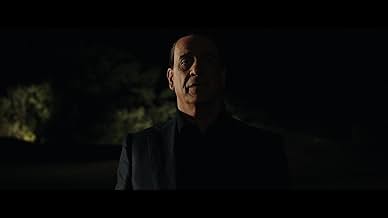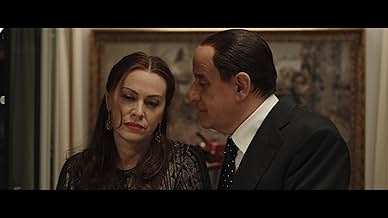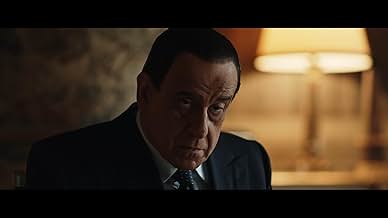IMDb रेटिंग
6.7/10
7.6 हज़ार
आपकी रेटिंग
अपनी भाषा में प्लॉट जोड़ेंAn escort-service owner uses his girls to get close to politician/PM and media mogul Silvio Berlusconi, but in 2006 he's preoccupied with his shaky marriage and losing an election.An escort-service owner uses his girls to get close to politician/PM and media mogul Silvio Berlusconi, but in 2006 he's preoccupied with his shaky marriage and losing an election.An escort-service owner uses his girls to get close to politician/PM and media mogul Silvio Berlusconi, but in 2006 he's preoccupied with his shaky marriage and losing an election.
- पुरस्कार
- कुल 1 जीत
कहानी
क्या आपको पता है
- ट्रिवियाThis 145-minute cut combines scenes from both Loro 1 (2018) and Loro 2 (2018). It has been made in order to allow the movie to be released outside of Italy as a standalone film.
- भाव
Kira: Do you believe in God?
Sergio Morra: Of course. Well, only on Mondays...
फीचर्ड रिव्यू
Paolo Sorrentino's Loro is what can only be described as very, very Sorrentino; a pure distillation of his overriding thematic concerns and an anthology-like compendium of his stylistic tendencies. This is Sorrentino at his most Sorrentino-like. Released in Italy in two parts, Loro 1 (2018) ran 104 minutes and Loro 2 (2018) ran 100 minutes, the film was released internationally as one piece, running 145 minutes. Very much a thematic companion piece to Il divo (2008), and stylistically similar to the Oscar-winning masterpiece The Great Beauty (2013), Loro is more interested in extravagant hedonism and Dionysian excess than the former and more satirical than the latter. Visually stunning, with a towering central performance from Toni Servillo (working with Sorrentino for the sixth time), some will criticise the film as all style, no substance; some will decry the lack of a strong forward-moving plot; some will take issue with the fact that Sorrentino seems reluctant to condemn Berlusconi; some will argue that in attempting to satirise the commodification of the female body, Sorrentino simply reproduces such commodification; some will find it too glossy and unrealistic; some will find it vulgar; some will find it sordid; some will regard the aping of Federico Fellini as too on the nose. And there's validity in each position, to one degree or another. As I said, it's very, very Sorrentino.
Written with his regular writing partner Umberto Contarello, Loro tells the "partly fictionalised" story of Silvio Berlusconi (Servillo) from the April 2006 general election (which he lost by a tiny margin) to the April 2009 L'Aquila earthquake and his return to power. Initially, we follow Sergio Morra (Riccardo Scamarcio), a pimp hoping to ingratiate himself with Berlusconi, to which end he rents the residence next door to Berlusconi's summer residence in Sardinia. Hoping the sight of the escorts partying will attract Berlusconi, unbeknownst to Morra, however, Berlusconi's attention is elsewhere. Finding himself in a political position to which he is unaccustomed (leader of the opposition), he is at something of a loss as to how to fill his day. Additionally, his marriage to Veronica Lario (Elena Sofia Ricci) is breaking down.
As will come as a shock to precisely no one, Loro looks absolutely amazing. There's Luca Bigazzi's gorgeous and vibrant cinematography, rendering Sardinia as a lazy, sun-kissed nirvana; Stefania Cella's luxurious and gaudy production design; Carlo Poggioli's decadent and seductive wardrobe; and Maurizio Silvi's makeup, hilariously recreating Berlusconi's waxen surgery-enhanced features and permatan, effectively turning Servillo into a human Ken doll. Sorrentino employs such lush, over-the-top beauty because he is satirising soulless elegance; that which is aesthetically pleasing but metaphysically empty. All-but drowning the audience in extraordinary, but ultimately meaningless opulence, however, he does run the risk of being accused of recreating and thus partially validating that which he has set out to satirise.
It's a fine line, but he walks it consistently. Take, for example, how he employs female nudity, of which there is a huge amount, almost all void of much in the way of narrative justification. On the surface, it's gratuitous nudity-for-nudity's sake. However, the lack of a meaningful rationale is precisely the point; to show that the characters dispassionately view women as commodities. Every male, and even some of the females (for example, Morra's business partner Tamara (Euridice Axen), and Kira (Kasia Smutniak), an acquaintance of Berlusconi's with whom Morra becomes infatuated) look at the escorts as objects whose bodies are for nothing beyond satisfying the lust of lascivious men and generating profit for their pimps, and the sight of so many beautiful young women degrading themselves for lecherous old men leaves a nasty aftertaste, precisely as is intended.
One of the most interesting facets of the film is how relatively lenient Sorrentino is - Berlusconi is not exactly sympathetic, but neither is he what you would call a villain. In this sense, the film reminded me of Oliver Stone's W. (2008). Part of the reason Berlusconi comes across as not completely reprehensible is because of Servillo, who is too intelligent a performer to allow any role to lapse into caricature. His Berlusconi remains always a bully, but he's also a man horrified by growing old, and his refusal to go gently into that good night is mixed with the occasional bout of regret. Servillo especially lets us see just how much it genuinely hurts Berlusconi when his marriage breaks down, as he is still desperately in love with Veronica, despite the fact that his behaviour has led her to despise him. On a more superficial level, Servillo perfectly captures Berlusconi's ridiculous grin, his obsession with opulence, his disdain for etiquette, and his ability to spin anything to make himself look good irrespective of the facts clearly showing that he's lying (and yes, it's supposed to remind us of a certain pathological liar currently living at 1600 Pennsylvania Avenue NW).
Thematically, a major issue is acquisition; of capital, of property, of power, of influence, of anything. The driving force of so many of the characters (especially people like Morra, Tamara, and Kira) is simply "more". These are people who can literally never be satisfied. Indeed, on three separate occasions, a character says, "Having it all isn't enough". Berlusconi's attitude to holding public office is similar, and is brilliantly dramatised in arguably the film's best scene. After deciding to return to politics, he tests himself to see whether he still has "it." Randomly cold-calling a gloomy housewife, he proceeds to sell her a luxury apartment that he admits hasn't even been built yet. It's a Servillo acting masterclass, and it's very funny, but it's also very telling - rather than brushing up on policy, or trying to clean his image up, this is how he prepares himself to attempt to topple the sitting government.
Another theme is the normalisation of decadence. For example, we see cocaine being snorted off escorts' naked bodies so often that by the time we get to the last half-hour or so, we don't even register it anymore. This isn't the case of a filmmaker accidentally overexposing a trope. Rather, overexposure is the trope; something like this should never be normalised, yet in this environment it most certainly is. In one brilliantly staged scene, as Morra and his escorts are walking through Rome, a garbage truck crashes and explodes, throwing its contents into the air before it rains down on the escorts. However, just as the garbage reaches them, the film cuts to a pool party in Morra's villa, and instead of garbage falling from the sky, the escorts are instead in the middle of a shower of ecstasy tablets.
However, for all its strengths, Loro is nowhere near the quality of Sorrentino's recent English-language output - This Must Be the Place (2011), the horrifically underrated Youth (2015), and the glorious The Young Pope (2016), whilst it pales in comparison to La grande bellezza (for my money one of the top twenty films of the century, thus far). Sure, this is perhaps the most quintessential Sorrentino film he has yet made, and everything that makes a film a "Sorrentino film" is present and accounted for - the visual opulence, the hedonistic milieu, the undercurrent of corruption and greed, the casual sexuality. However, unlike, say, La grande bellezza or The Young Pope, in Loro, the visual panache can often come across as an end unto itself, rather than serving the story and/or themes.
The biggest problem, however, is that structurally, the international cut is unable to escape the bifurcated narrative design of the original edits, with the story narratively and thematically divided into two halves. The first half focuses on Morra and a group of politicians and hangers-on (the eponymous "loro", meaning them); the second half focuses more tightly on Berlusconi himself, especially his relationship with Veronica, with the film rarely leaving his Sardinian estate. And as you can probably imagine, the transition is not entirely smooth, with entire subplots abandoned without explication or resolution, and important characters fade into the background and often disappear (Morra himself features in only a couple of scenes in the second half).
That said, however, this is still Sorrentino, so no matter the problems, there's always going to be much to admire. He's a master auteur and here turning his attention to perhaps Italy's most notorious post-War politician, he gets plenty of inspired mileage out of the tawdry subject matter. Very much a chronicler of the darkness behind Italy's sparkle, Sorrentino suggests that Berlusconi, and men like him, are driven by vanity and a desire for power as its own reward. Yes, the storyline is a little slack, and, yes, it somewhat unexpectedly finds humanity in the man, and yes, it's Sorrentino's weakest film for a while. But it's also a Sorrentino film. And for that, if nothing else, it's worth a look.
Written with his regular writing partner Umberto Contarello, Loro tells the "partly fictionalised" story of Silvio Berlusconi (Servillo) from the April 2006 general election (which he lost by a tiny margin) to the April 2009 L'Aquila earthquake and his return to power. Initially, we follow Sergio Morra (Riccardo Scamarcio), a pimp hoping to ingratiate himself with Berlusconi, to which end he rents the residence next door to Berlusconi's summer residence in Sardinia. Hoping the sight of the escorts partying will attract Berlusconi, unbeknownst to Morra, however, Berlusconi's attention is elsewhere. Finding himself in a political position to which he is unaccustomed (leader of the opposition), he is at something of a loss as to how to fill his day. Additionally, his marriage to Veronica Lario (Elena Sofia Ricci) is breaking down.
As will come as a shock to precisely no one, Loro looks absolutely amazing. There's Luca Bigazzi's gorgeous and vibrant cinematography, rendering Sardinia as a lazy, sun-kissed nirvana; Stefania Cella's luxurious and gaudy production design; Carlo Poggioli's decadent and seductive wardrobe; and Maurizio Silvi's makeup, hilariously recreating Berlusconi's waxen surgery-enhanced features and permatan, effectively turning Servillo into a human Ken doll. Sorrentino employs such lush, over-the-top beauty because he is satirising soulless elegance; that which is aesthetically pleasing but metaphysically empty. All-but drowning the audience in extraordinary, but ultimately meaningless opulence, however, he does run the risk of being accused of recreating and thus partially validating that which he has set out to satirise.
It's a fine line, but he walks it consistently. Take, for example, how he employs female nudity, of which there is a huge amount, almost all void of much in the way of narrative justification. On the surface, it's gratuitous nudity-for-nudity's sake. However, the lack of a meaningful rationale is precisely the point; to show that the characters dispassionately view women as commodities. Every male, and even some of the females (for example, Morra's business partner Tamara (Euridice Axen), and Kira (Kasia Smutniak), an acquaintance of Berlusconi's with whom Morra becomes infatuated) look at the escorts as objects whose bodies are for nothing beyond satisfying the lust of lascivious men and generating profit for their pimps, and the sight of so many beautiful young women degrading themselves for lecherous old men leaves a nasty aftertaste, precisely as is intended.
One of the most interesting facets of the film is how relatively lenient Sorrentino is - Berlusconi is not exactly sympathetic, but neither is he what you would call a villain. In this sense, the film reminded me of Oliver Stone's W. (2008). Part of the reason Berlusconi comes across as not completely reprehensible is because of Servillo, who is too intelligent a performer to allow any role to lapse into caricature. His Berlusconi remains always a bully, but he's also a man horrified by growing old, and his refusal to go gently into that good night is mixed with the occasional bout of regret. Servillo especially lets us see just how much it genuinely hurts Berlusconi when his marriage breaks down, as he is still desperately in love with Veronica, despite the fact that his behaviour has led her to despise him. On a more superficial level, Servillo perfectly captures Berlusconi's ridiculous grin, his obsession with opulence, his disdain for etiquette, and his ability to spin anything to make himself look good irrespective of the facts clearly showing that he's lying (and yes, it's supposed to remind us of a certain pathological liar currently living at 1600 Pennsylvania Avenue NW).
Thematically, a major issue is acquisition; of capital, of property, of power, of influence, of anything. The driving force of so many of the characters (especially people like Morra, Tamara, and Kira) is simply "more". These are people who can literally never be satisfied. Indeed, on three separate occasions, a character says, "Having it all isn't enough". Berlusconi's attitude to holding public office is similar, and is brilliantly dramatised in arguably the film's best scene. After deciding to return to politics, he tests himself to see whether he still has "it." Randomly cold-calling a gloomy housewife, he proceeds to sell her a luxury apartment that he admits hasn't even been built yet. It's a Servillo acting masterclass, and it's very funny, but it's also very telling - rather than brushing up on policy, or trying to clean his image up, this is how he prepares himself to attempt to topple the sitting government.
Another theme is the normalisation of decadence. For example, we see cocaine being snorted off escorts' naked bodies so often that by the time we get to the last half-hour or so, we don't even register it anymore. This isn't the case of a filmmaker accidentally overexposing a trope. Rather, overexposure is the trope; something like this should never be normalised, yet in this environment it most certainly is. In one brilliantly staged scene, as Morra and his escorts are walking through Rome, a garbage truck crashes and explodes, throwing its contents into the air before it rains down on the escorts. However, just as the garbage reaches them, the film cuts to a pool party in Morra's villa, and instead of garbage falling from the sky, the escorts are instead in the middle of a shower of ecstasy tablets.
However, for all its strengths, Loro is nowhere near the quality of Sorrentino's recent English-language output - This Must Be the Place (2011), the horrifically underrated Youth (2015), and the glorious The Young Pope (2016), whilst it pales in comparison to La grande bellezza (for my money one of the top twenty films of the century, thus far). Sure, this is perhaps the most quintessential Sorrentino film he has yet made, and everything that makes a film a "Sorrentino film" is present and accounted for - the visual opulence, the hedonistic milieu, the undercurrent of corruption and greed, the casual sexuality. However, unlike, say, La grande bellezza or The Young Pope, in Loro, the visual panache can often come across as an end unto itself, rather than serving the story and/or themes.
The biggest problem, however, is that structurally, the international cut is unable to escape the bifurcated narrative design of the original edits, with the story narratively and thematically divided into two halves. The first half focuses on Morra and a group of politicians and hangers-on (the eponymous "loro", meaning them); the second half focuses more tightly on Berlusconi himself, especially his relationship with Veronica, with the film rarely leaving his Sardinian estate. And as you can probably imagine, the transition is not entirely smooth, with entire subplots abandoned without explication or resolution, and important characters fade into the background and often disappear (Morra himself features in only a couple of scenes in the second half).
That said, however, this is still Sorrentino, so no matter the problems, there's always going to be much to admire. He's a master auteur and here turning his attention to perhaps Italy's most notorious post-War politician, he gets plenty of inspired mileage out of the tawdry subject matter. Very much a chronicler of the darkness behind Italy's sparkle, Sorrentino suggests that Berlusconi, and men like him, are driven by vanity and a desire for power as its own reward. Yes, the storyline is a little slack, and, yes, it somewhat unexpectedly finds humanity in the man, and yes, it's Sorrentino's weakest film for a while. But it's also a Sorrentino film. And for that, if nothing else, it's worth a look.
टॉप पसंद
रेटिंग देने के लिए साइन-इन करें और वैयक्तिकृत सुझावों के लिए वॉचलिस्ट करें
- How long is Loro?Alexa द्वारा संचालित
विवरण
- रिलीज़ की तारीख़
- कंट्री ऑफ़ ओरिजिन
- आधिकारिक साइटें
- भाषा
- इस रूप में भी जाना जाता है
- Them
- फ़िल्माने की जगहें
- Ansedonia, Orbetello, Grosseto, Tuscany, इटली(Villa Morena in Sardegna: 20 Via delle Mimose)
- उत्पादन कंपनियां
- IMDbPro पर और कंपनी क्रेडिट देखें
बॉक्स ऑफ़िस
- US और कनाडा में सकल
- $35,613
- US और कनाडा में पहले सप्ताह में कुल कमाई
- $5,317
- 22 सित॰ 2019
- दुनिया भर में सकल
- $36,567
- चलने की अवधि2 घंटे 31 मिनट
- रंग
- पक्ष अनुपात
- 2.40 : 1
इस पेज में योगदान दें
किसी बदलाव का सुझाव दें या अनुपलब्ध कॉन्टेंट जोड़ें



































